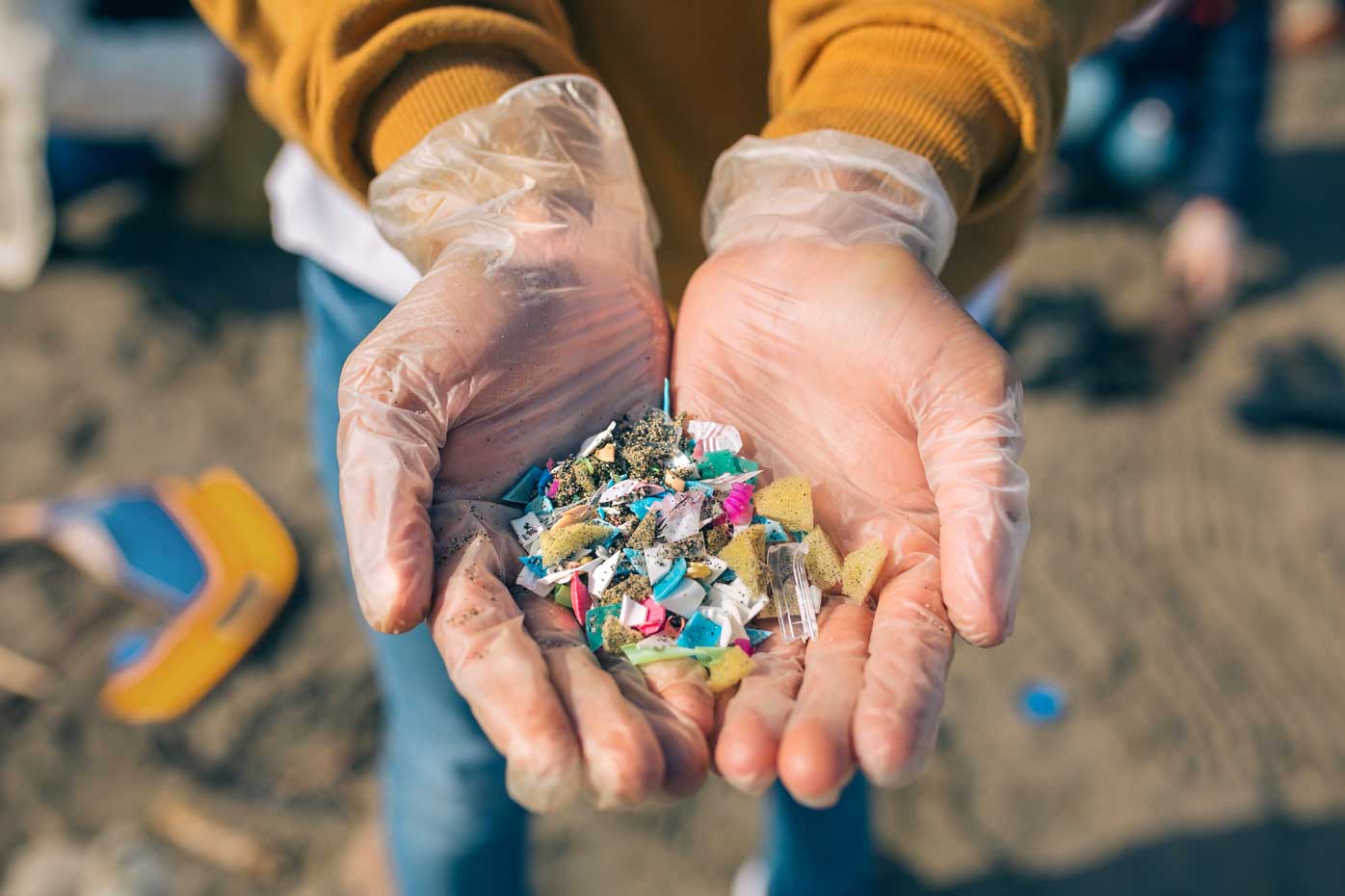There is growing awareness that the release of microplastics (MPs) into the environment can harm organisms, the environment, and potentially impact human health.
The term ”microplastics” was introduced in 2004 to describe minute plastic particles, defined by the U.S. National Oceanic and Atmospheric Administration (NOAA) as ”plastic particles smaller than 5mm,” but there is no universally accepted definition.[1] MPs are generally considered to range in size from 1µm (micrometer) to 5000µm (5mm), while plastic particles less than 1µm in size are known as nanoplastics (NPs).[2]
MPs are either primary or secondary plastics. Primary plastics are micronized for use, for example microbeads in cosmetics and microfibers in clothing, while secondary plastics are larger plastics broken down over time by environmental factors, such as abrasion, ocean waves, ultra-violet radiation, and photo-oxidation (light degradation).[3]
Microplastics in the Environment
The mass production of plastics commenced in the 1950s, and today more than 350 million tons of plastic are produced each year.[4] An estimated 12 billion tons of plastic waste will be found in landfills and the natural environment by 2050. Around 3% of plastic waste enters the oceans annually, with an estimated 82-368 trillion plastic particles currently in the ocean surface layer.[5,6] MPs are also found in the air as particulate matter, defined as particles with a diameter of <2.5µm.[7]
Initial research suggests that MPs may negatively impact human health, but evidence to quantify that impact is currently insufficient. At present, a lack of standardized methods for sampling, extracting, and analyzing MPs in the environment makes it difficult to accurately compare study results and draw any definitive conclusions. What is known is that MPs are found in many parts of the body, including the lungs, liver, brain, kidneys, bowel, and blood vessels.[2] MPs smaller than 20µm can penetrate human organs, while smaller particles around 10µm can cross cell membranes, the blood-brain barrier, and enter the placenta.[4, 8] However, as capillaries are only 5-8µm in diameter, this limits the size of plastic particles that can circulate in the microvessels, reducing the likelihood of entering the bloodstream and causing disease.[9]
Microplastics can be toxic in several ways: through the particles themselves, the chemicals involved in their make-up, and the microorganisms that can attach to MPs, known as biofilms. Biofilms form when microorganisms grow on surfaces such as microplastics, including microbial pathogens such as Pseudomonas aeruginosa, which can cause serious infections in humans, potentially contributing to the growing problem of antimicrobial resistance.[10] Changes to the microbial content in the gut can affect human health, but evidence showing a link between MPs, microorganisms, and the gut microbiota and adverse health consequences remains limited.[3]
Routes of Transmission and Elimination
Human exposure to MPs can occur via three routes: ingestion, inhalation, and skin contact. Ingestion through drinking or eating is the primary route, for example, drinking from plastic water bottles or eating contaminated food, such as fish and shellfish. MPs are found in treated and untreated tap water and have been identified in fruits, vegetables, chicken, eggs, salt, sugar, honey, milk, and soft drinks.[4]
Estimates suggest that a person could consume up to 52,000 particles of plastic each year, increasing to 121,000 if including those inhaled.[1] That means a person could potentially consume around 5g of microplastics a week through food and drink intake.[11]
Table 1: Estimated Per Capita Ingestion of Microplastic Particles [7]
Particles can also be inhaled, leading to the absorption of MPs from the mucosa within the lungs.[12] Inhalation of plastic fibers has been shown to cause some cancers and lead to an inflammatory response in the lungs and respiratory irritation.[3] Particles >2µm are more likely to deposit in the upper respiratory tract, while particles between 0.01µm and 1µm are more likely to deposit deeper in the lungs.[7] The human lung has a very thin tissue barrier, smaller than 1µm, allowing NPs to penetrate the bloodstream and travel to all parts of the human body.[8]
A recent study found microplastics in the blood of 80% of the people evaluated. Half the samples contained polyethylene terephthalate (PET) plastic, commonly used in drinks bottles; a third contained polystyrene, often used in plastic food packaging; and a quarter contained polyethylene (PE), used to make plastic bags. Another study reported that MPs attach to the outer membranes of red blood cells, limiting their ability to transport oxygen around the body.[9]
It is also possible for NPs to be absorbed through the skin via washing or using cosmetics that contain primary plastics, allowing particles <0.1µm to cross the dermal barrier.[4,8]
The discharge of MPs from the human body occurs via excretion in fecal matter or renal filtration and the urinary tract, but it is not known how long MPs remain in circulation after dietary exposure before being excreted nor what impact this has on human health.[13]
What is the Impact on Human Health?
In 2019, the World Health Organization (WHO) published a report on MPs in drinking water, stating that they posed a low concern for human health and that more data was needed on the most common forms of plastic particles relevant for human health risk assessment.[10] A subsequent WHO report in 2022 evaluated the risks of MPs and NPs to human health from dietary intake and inhalation, concluding that the available data were insufficient to conduct a full risk assessment and that the limited data provided little evidence that MPs had adverse effects on humans.[7]
MPs identified in fecal matter in patients with inflammatory bowel disease (IBD), including Crohn’s disease and ulcerative colitis, have been found at higher concentrations than in healthy people – 41.8 items per gram of dry matter (g dm) versus 28 items per g dm – suggesting that MP exposure at high concentrations may be related to the disease process. Other studies report that MPs can cause intestinal inflammation, oxidative stress, increased permeability, and microbial dysbiosis. Although the exact cause of IBD remains unidentified, IBD is associated with environmental, bacterial, and immune-related factors.[14]
A recent study looking at the presence of MPs per 1g of colon tissue in colorectal adenocarcinoma (CRA) patients found that the number of MPs extracted from tumoral colon tissue in patients with CRA was significantly higher (702.68 particles) than in non-tumoral colon tissues of patients with (207.78) or without (218.28) CRA.[11] Further evidence from occupational risk studies indicates that MPs may be a potential cause of colorectal cancer (CRC).[15] Today, CRC is the third most common cancer globally and the fourth leading cause of cancer deaths worldwide.[11] Approximately 90% of the 1.9 million new cases diagnosed in 2020 were adenocarcinomas.[16]
In the U.S., CRC is now the leading cause of cancer-related death in men under the age of 50. Data shows that CRC incidence in people under 55 nearly doubled from 11% in 1995 to 20% in 2019 and that the proportion of rectal cancers increased from 27% in 1995 to 31% in 2019. More young patients are presenting with left-sided tumors and advanced-stage CRC, reflecting changes in underlying disease risk of unknown origin, with younger patients having a worse prognosis than older patients.[17]
Cancer trends in young adults are a useful indicator of the influence of modern-day exposures to substances not previously prevalent in society. Clearly, there are known risk factors for developing cancer, such as smoking, alcohol consumption, and poor diet, but other factors, such as high red or processed meat consumption, lack of physical exercise, unnecessary use of antibiotics, and ingestion of particulate matter and MPs may increase the risk of early-onset CRC.[17]
Studies of human cells in culture have shown that NPs are cytotoxic at high concentrations in monocytic cells and can induce genotoxic stress and DNA damage in other cells. NPs released into the cell’s cytosol could potentially interact with the mitochondria, the nucleus, or cellular processes such as cell division, causing cellular stress responses and inflammation.[2] A meta-analysis of 17 studies looking at the impact of MPs on human cells concluded that larger amounts of ingested MPs caused cell death, allergic response, and damage to cell walls. The research also found that irregular-shaped plastics caused a greater proportion of cell death than spherical plastics.[18]
Studies have also found that a build-up of MPs/NPs in liver tissue could cause chronic inflammation, leading to liver disease and metabolic problems, while an accumulation in lung tissue could cause chronic pulmonary disorders. Other consequences could be blockages of blood vessels or gut microbiome dysfunction.[2]
Combatting Plastic Pollution
The United Nations (UN) Environment Programme is working toward minimizing plastic pollution’s adverse effects on the environment and human health through the establishment of a legally binding plastic pollution treaty. In March 2022, the new UN Environment Assembly adopted the ”End Plastics Pollution” resolution, designed to develop specific content of the new treaty, with the aim of completing its work by the end of 2024.[19]
The “End Plastic Pollution Campaign” is an initiative of Earthday.org to help people understand the impact of plastic pollution and reduce their use of plastics. Earth Day, commemorated on April 22 each year. aims to bring together stakeholders from all backgrounds to advance sustainability and climate action by advocating for national legislation and corporate commitments.
Conclusions
Human consumption of MPs is increasing, but although MPs have been identified in multiple sites around the body, little supporting evidence to date shows that their ingestion leads to acute toxicity or severe long-term health effects. More research is needed to ascertain what impact they have on human health and how this could affect mortality or morbidity rates.



